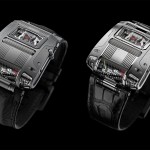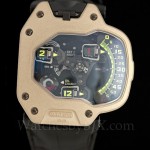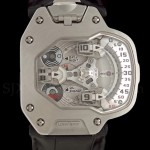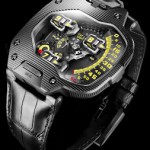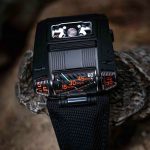Up Close: Urwerk UR-111C
A return to form for the avant-garde watchmaker.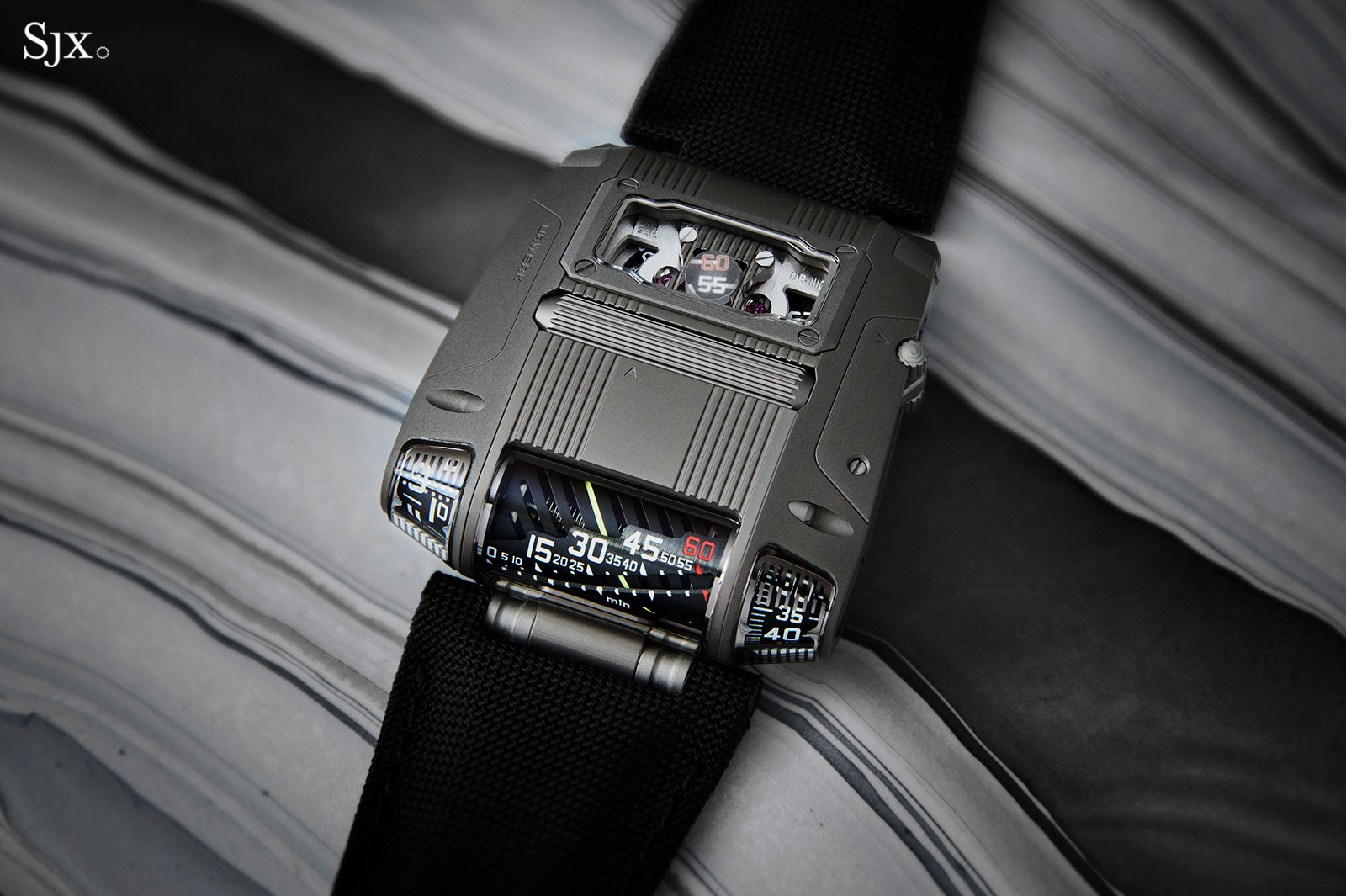
Though inspired by a 1999 Urwerk creation, which was itself inspired by a 1950s experimental watch, the UR-111C is still original and different enough to be the most compelling Urwerk wristwatch since the debut of the satellite cube display.
When it was founded in 1997 by watchmaker brothers Felix and Thomas Baumgartner, and designer Martin Frei, Urwerk relied on a simple but then radical formula – reinventing the classical wandering hours time display by installing it in an avant-garde watch case. They were aided by the precision machining specialist Christian Gros who’s responsible for many of the complex forms within and without an Urwerk watch, and still works with the brand today. That resulted in the watch that was decisive in establishing Urwerk on the horological map, the UR-103.01 of 2003.
But Urwerk’s greatest invention arrived in 2005, when Harry Winston unveiled the Opus V – developed and built by Urwerk – which told the time with a trio of rotating cubes and a retrograde hand. Originally and still compelling today, the satellite cube display is quintessentially Urwerk. Since then Urwerk’s watches have been improvements and iterations of either the wandering hours or satellite cube displays until the new UR-111C.
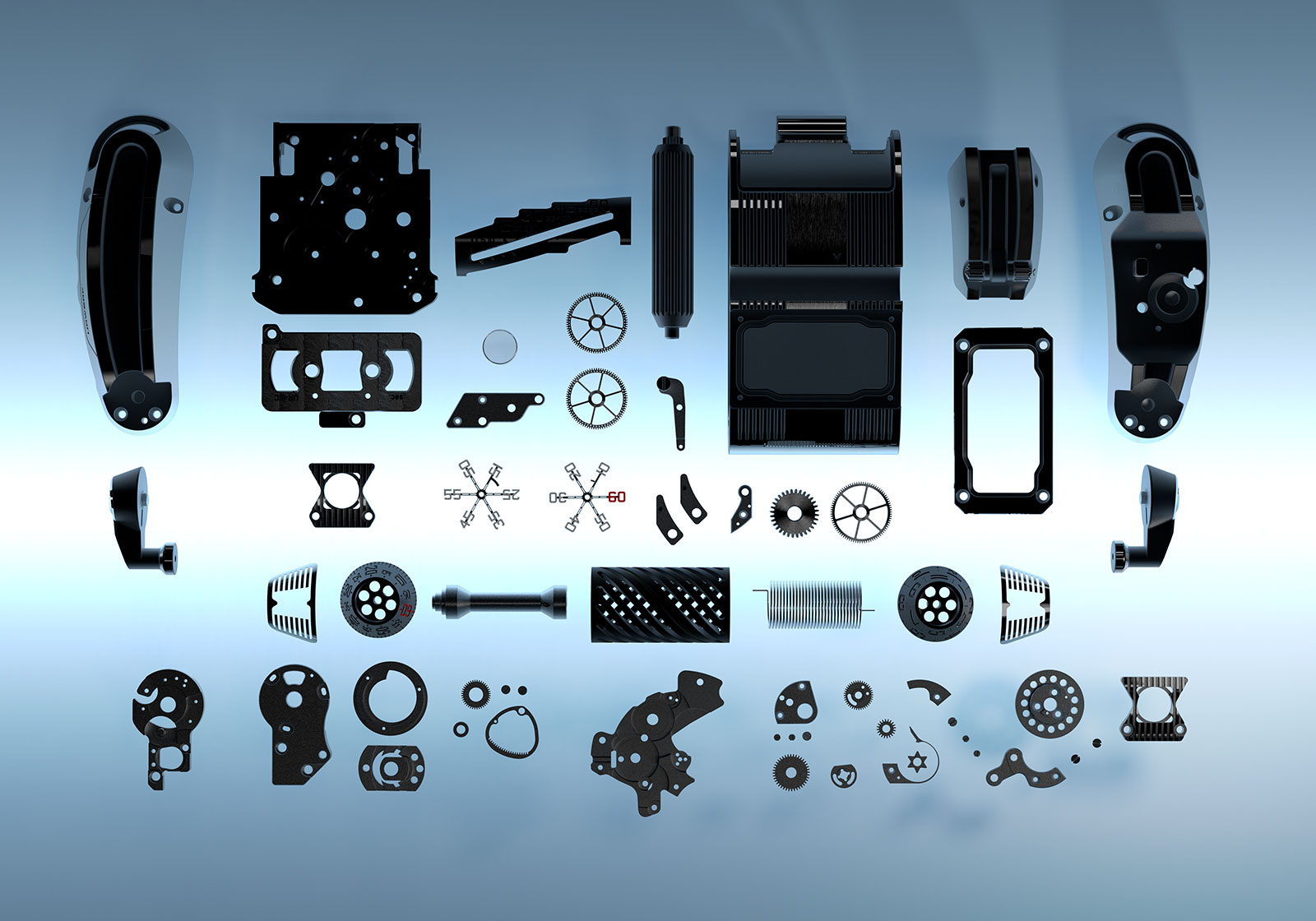
The UR-111C disassembled. Photo – Urwerk
The Cobra
The UR-111C originates with the UR-CC1 “King Cobra” of 2009, a large, intriguing, and for the period, preposterously expensive wristwatch that cost almost US$300,000. Fifty were made and it is unknown if the entire run was actually sold.
But the King Cobra was itself based on an equally radical wristwatch of 1958, the Patek Philippe ref. 3414 designed by Geneva jeweller Gilbert Albert and constructed by watchmaker Louis Cottier as a prototype. Housed in a chunky case with a bark finish, the watch indicated the time with twin linear displays, and was a glorious vision of the future as seen from the 1950s. But the idea never went anywhere and the prototype today remains in the Patek Philippe Museum.
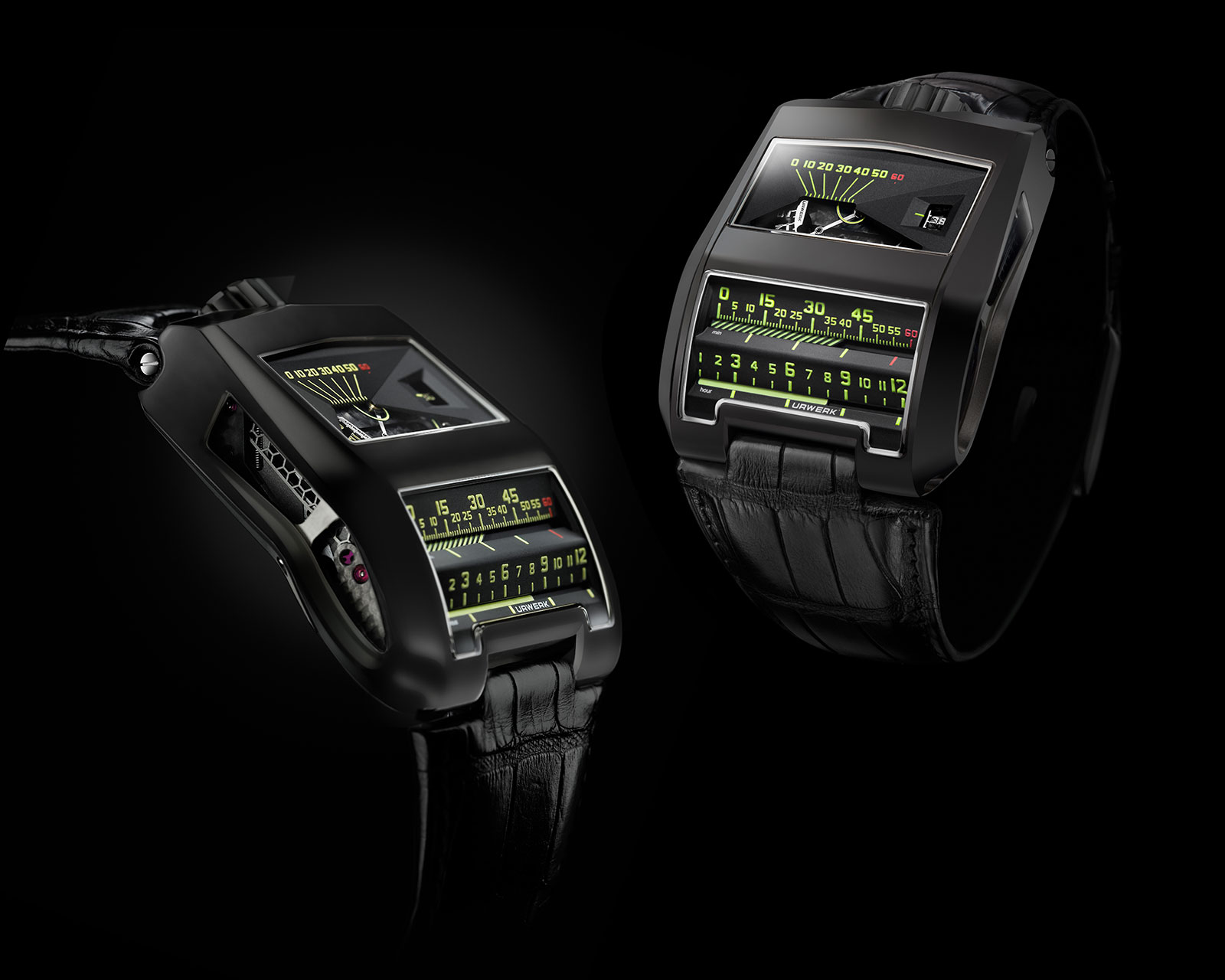
The UR-CC1 King Cobra with a black AlTiN coating. Photo – Urwerk
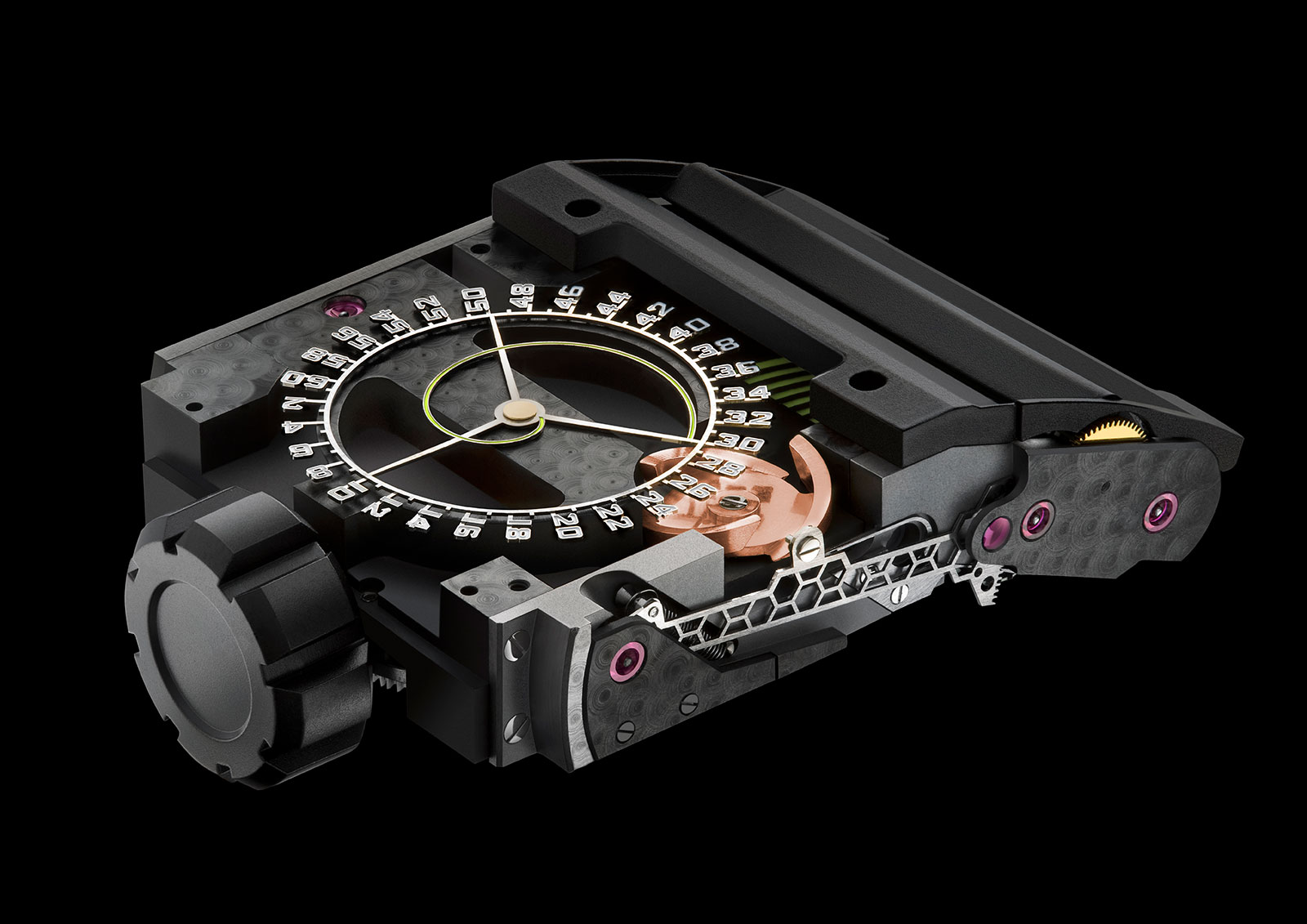
The calibre inside the UR-CC1. Photo – Urwerk
Explaining the UR-111C
The UR-111C is essentially an evolution of the King Cobra, but improved with additional features that boost legibility, a sleeker and more wearable case, and a much lower price. While the King Cobra had twin drums for a double linear display, as well as a single-disc digital seconds, the UR-111C relies on a single linear display and double digital seconds.
The key feature of the UR-111C is the linear time display under the oblong sapphire window on the lower front of the case. A cylindrical drum marked with a yellow line makes one revolution per hour, indicating the minutes as the yellow stripe advances upwards along the minute track, marked from “0” to “60” in five-minute intervals.
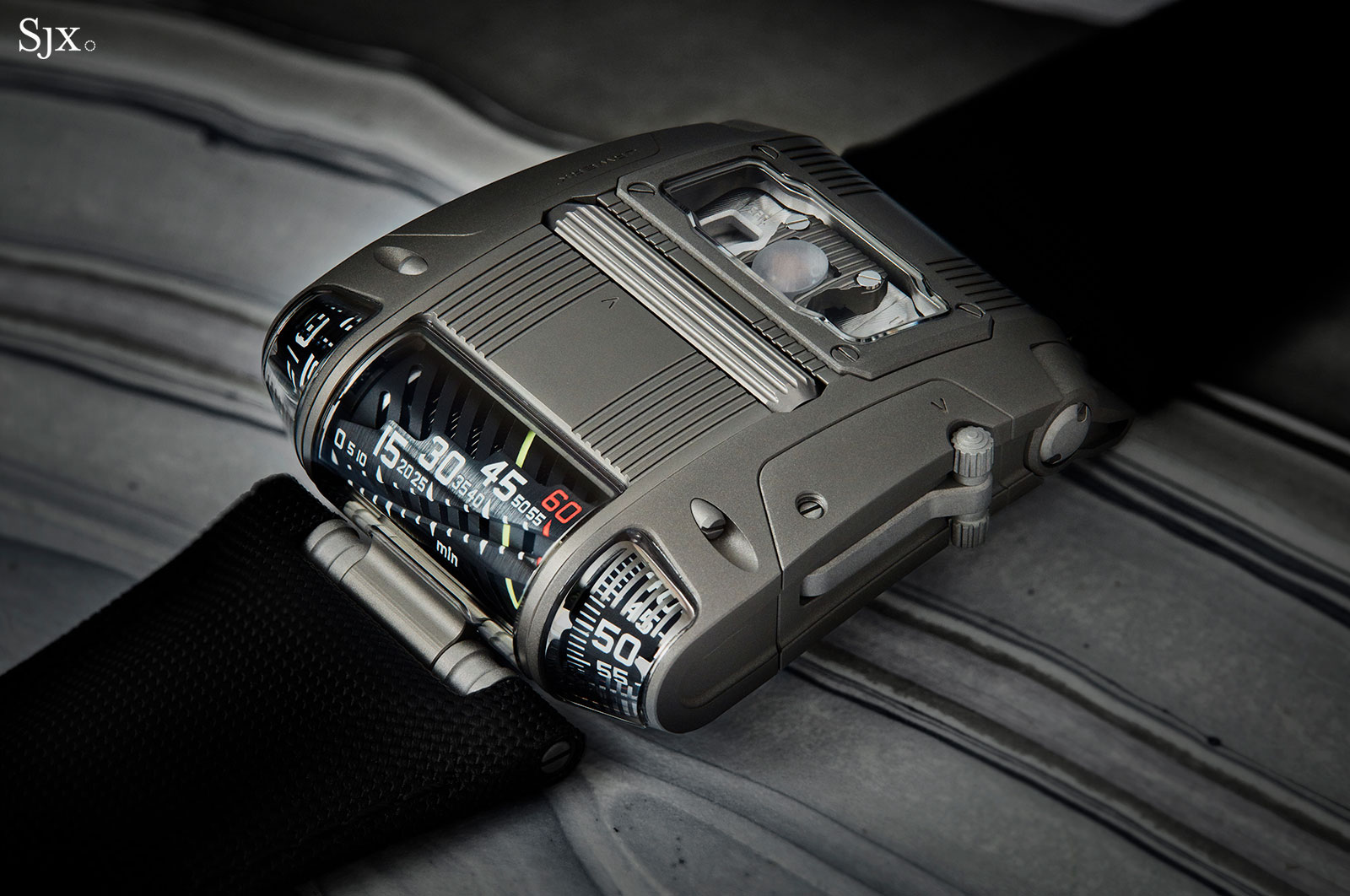
Although its form is unusual, the minutes are actually a highly complex retrograde display. At the top of the hour when the yellow marker hits “60”, the drum makes a larger, instantaneous jump to bring the marker back to zero. That’s possible thanks to a cylindrical spring sitting inside the drum that is wound up as the drum rotates and progresses towards the top of the hour, before releasing to return the drum back to zero.
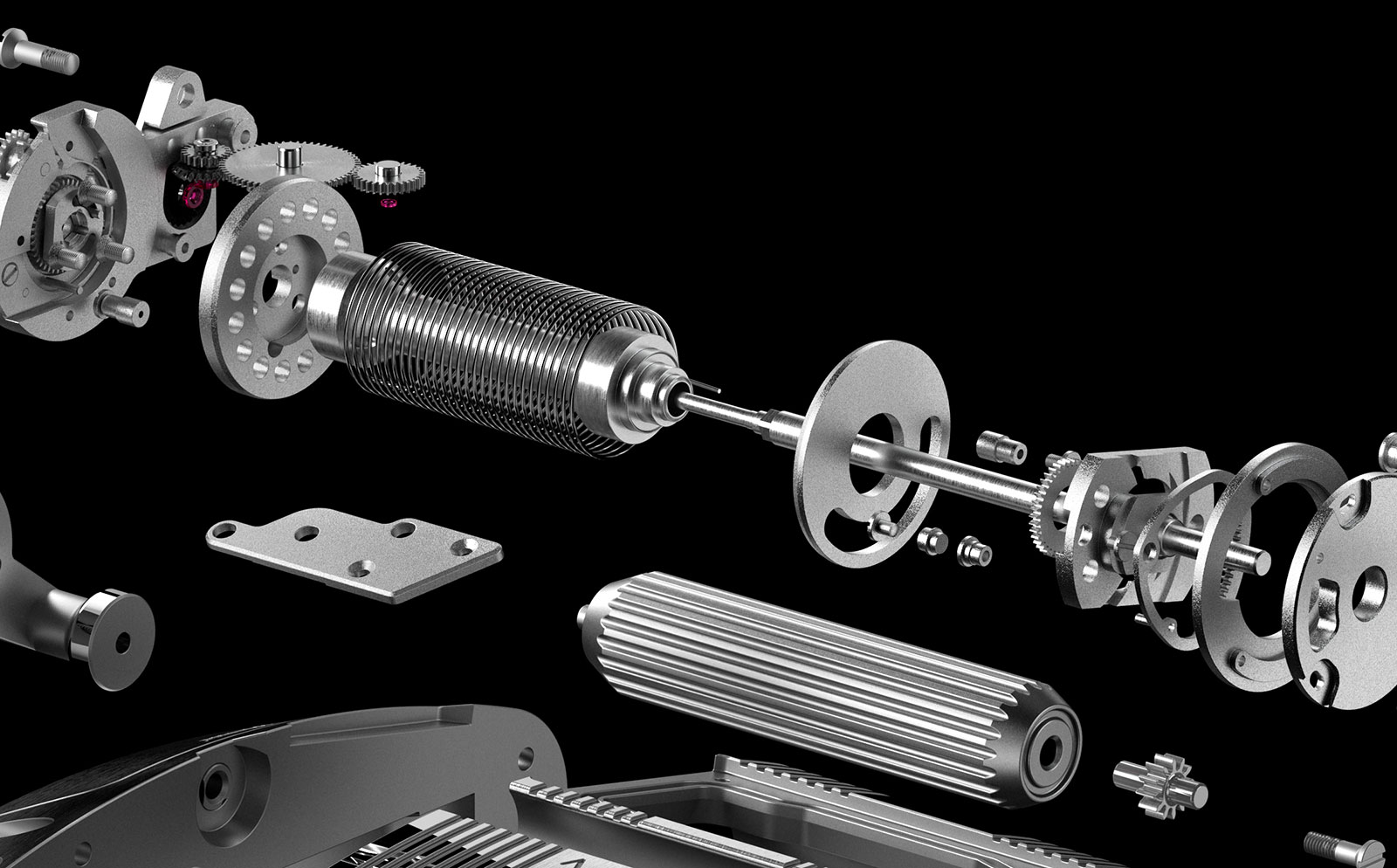
A closeup of the exploded movement detailing the spring that drives the retrograde cylinder display. Photo – Urwerk
For extra legibility a conical drum on the lower right corner of the case also indicates the minutes with single minute hashmarks. The hours are indicated on the opposite, lower right corner on a similar conical drum.
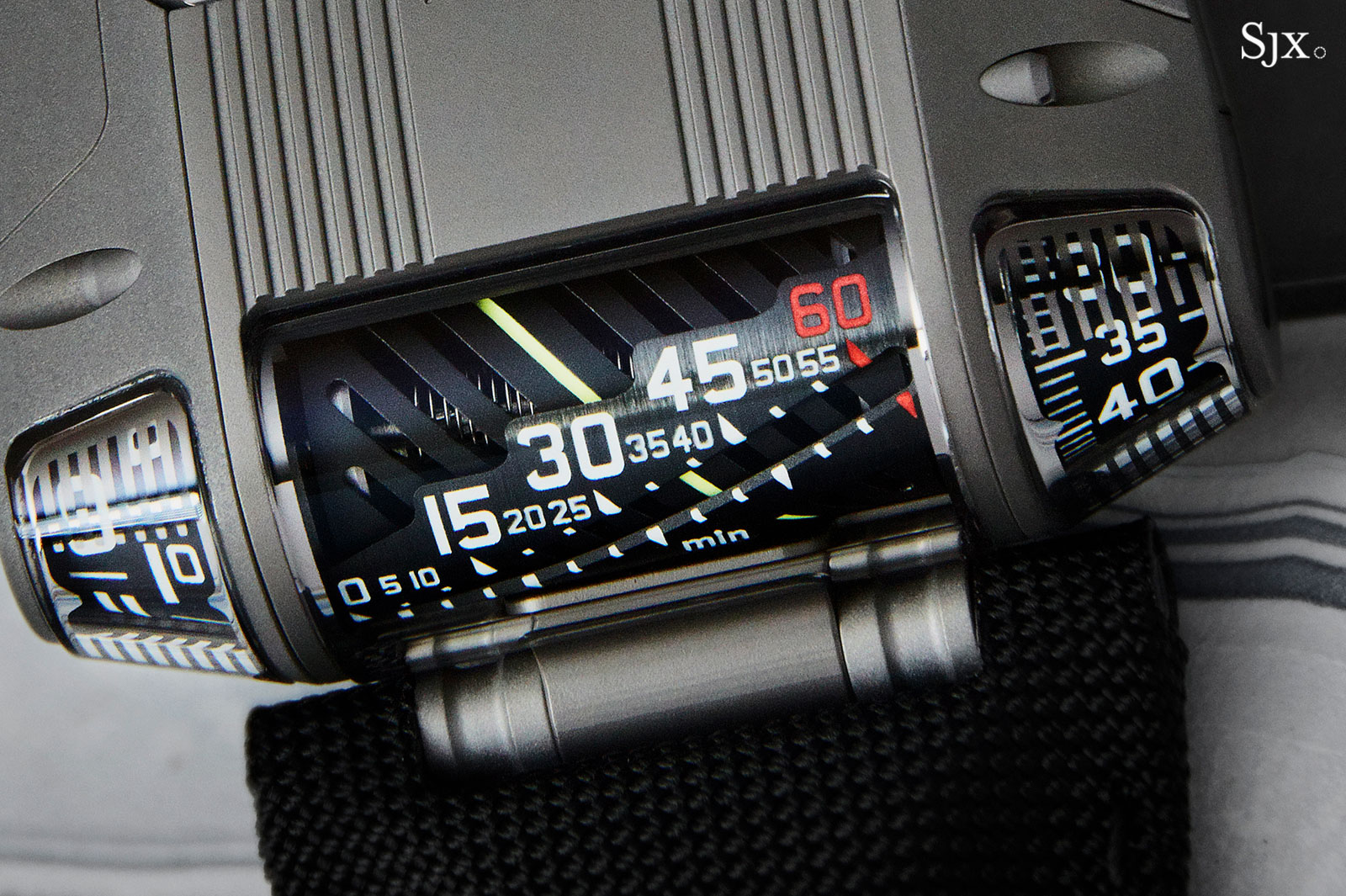
Taking inspiration from the seconds on the King Cobra, the seconds display is executed in an unusual form, with a pair of open-worked discs each carrying alternating seconds numerals in five-second intervals. Each disc turns in the opposite direction to the other, so the seconds numerals sweep downwards in the display.
But it is thanks to a thin slice of optical fibre – tightly bundled strands of glass individually as wide as a human hair – that the numerals are magnified and seemingly projected onto the surface of the sapphire window. The entire concept is a clever manner of displaying perhaps the most ordinary segment of the time.
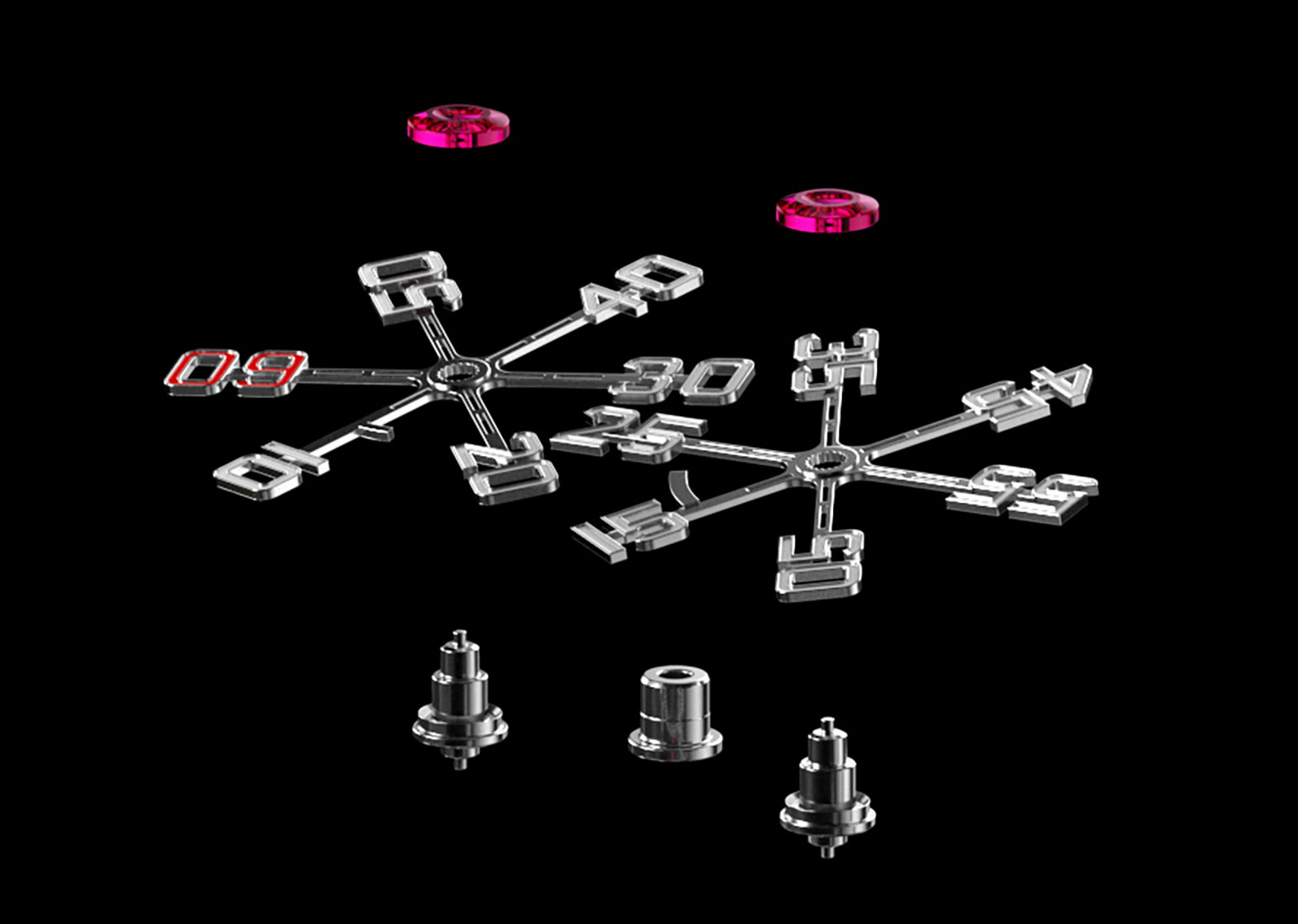
The twin seconds discs. Photo – Urwerk
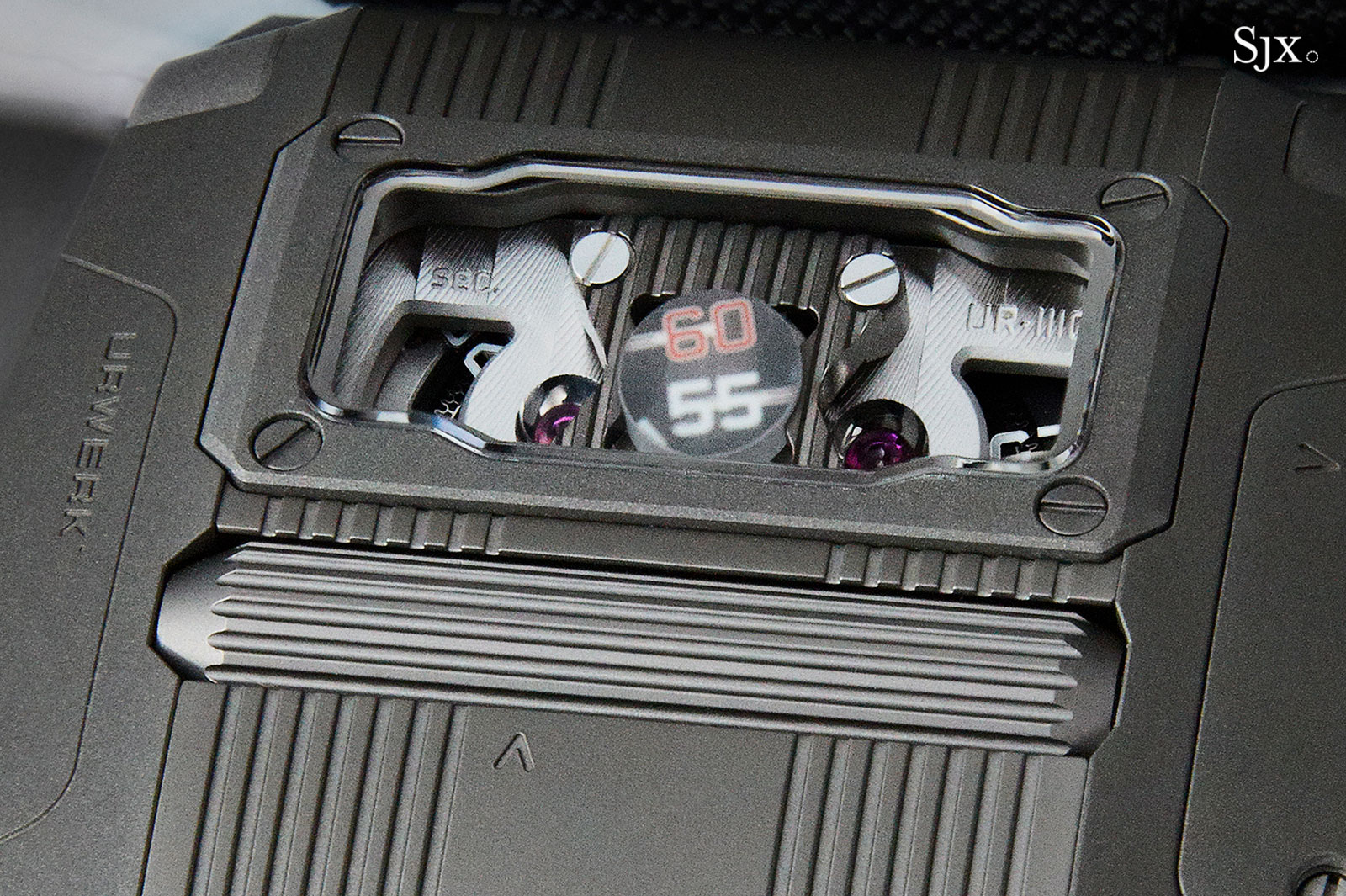
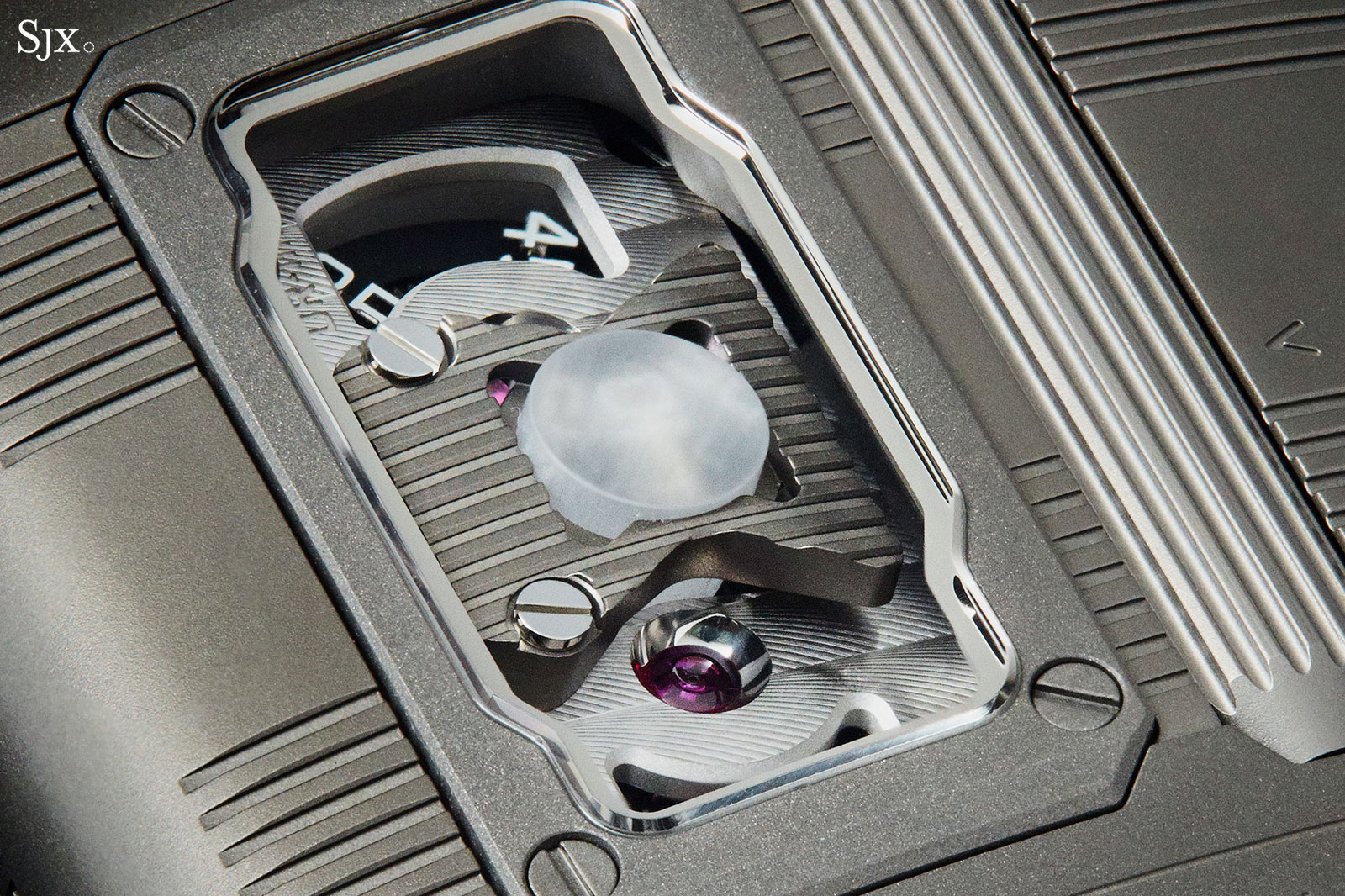
The optical fibre for the seconds display
Just below the window for the digital seconds is the roller crown, a long, fluted cylinder that is operated with the thumb to wind the watch. Pulling out a lever recessed into the right side of the case engages the time-setting mechanism, which is also operated by the roller.
While not as convenient as a conventional crown – it feels like more rotations of the roller are needed to accomplish the same task – the roller creates a cleaner case design, removing the enormous crown that was an Urwerk trademark in most of its watches.
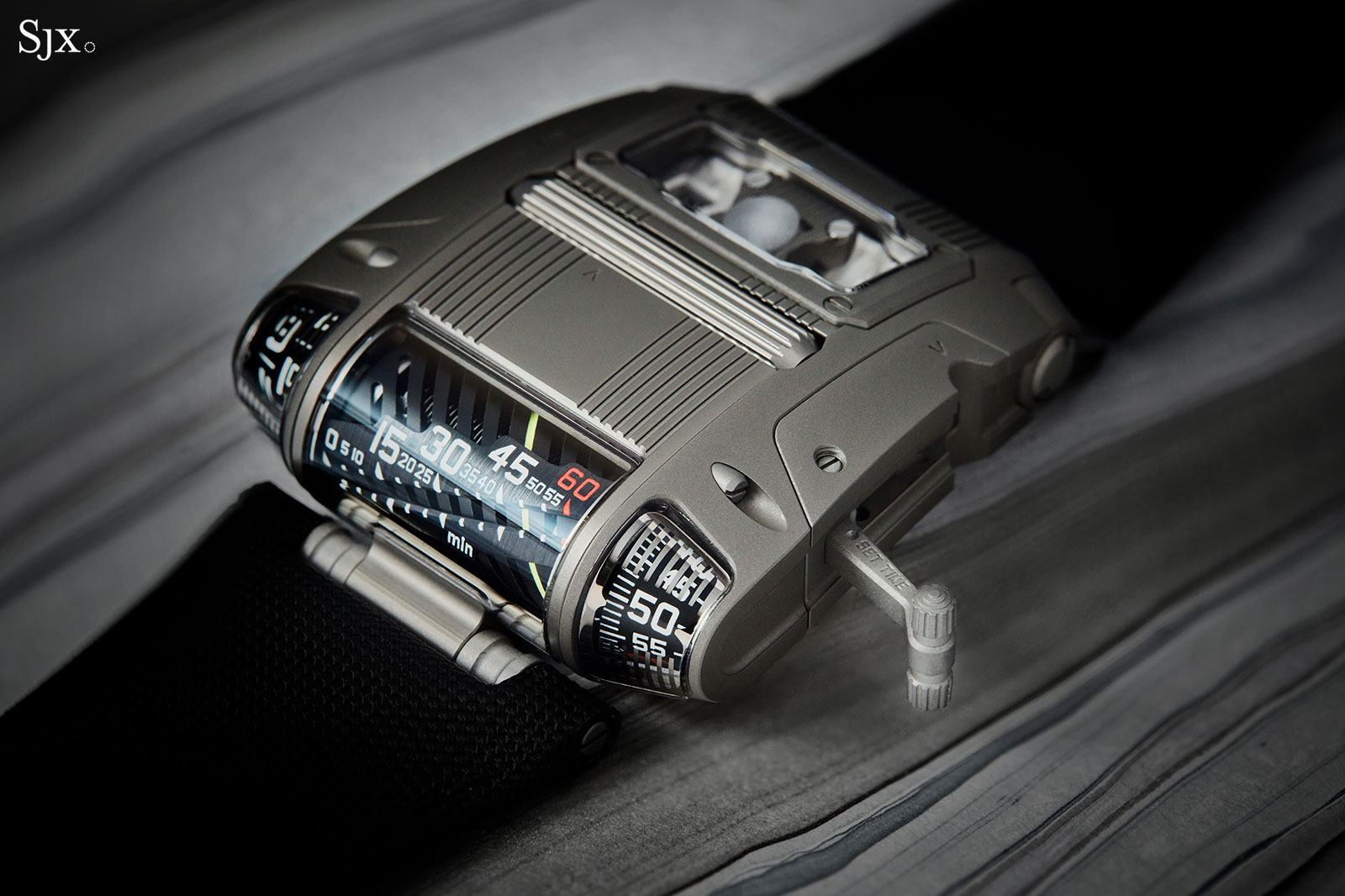
Driving all of the inventive mechanics is the prosaic but reliable Zenith Elite, the self-winding movement that is also the base for Urwerk’s other self-winding calibres, but practically unrecognisable within the proprietary Urwerk movement.
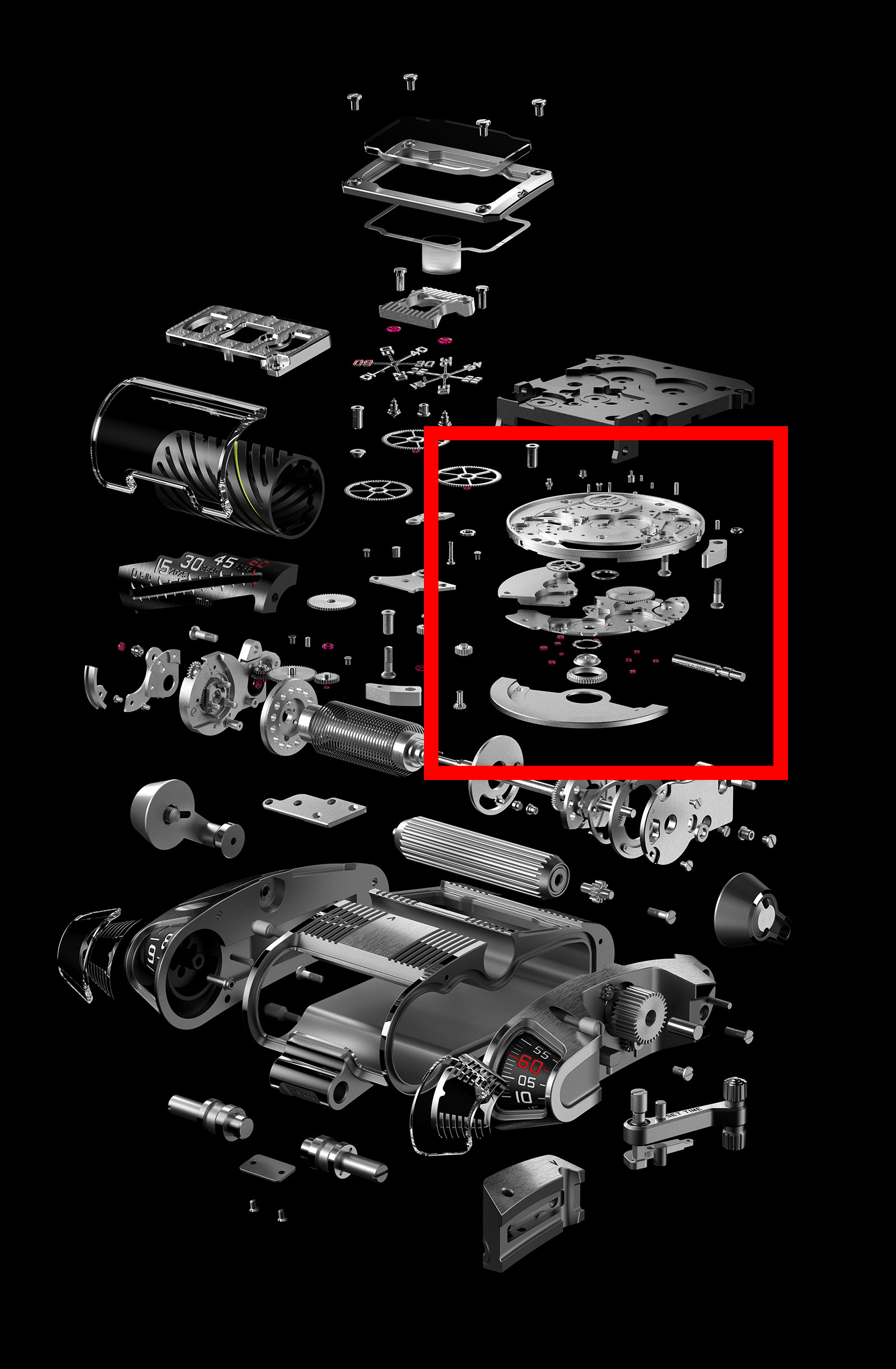
An exploded view of the entire watch, with the base movement highlighted. Photo – Urwerk
Hexagon no more
While an novel watch in itself, the UR-111C is also notable for departing from Urwerk’s most recent style of design, which tends towards large and aggressive. Its flagship, satellite cube-equipped UR-210 is reminiscent of the “hexagon” geometry favoured by Lamborghini, while the UR-T8 is big and scaly.
In comparison the UR-111C feels sleek. Measuring 42mm by 46mm and standing 15mm high, the UR-111C is a large but manageable watch, especially since the case is slightly curved.
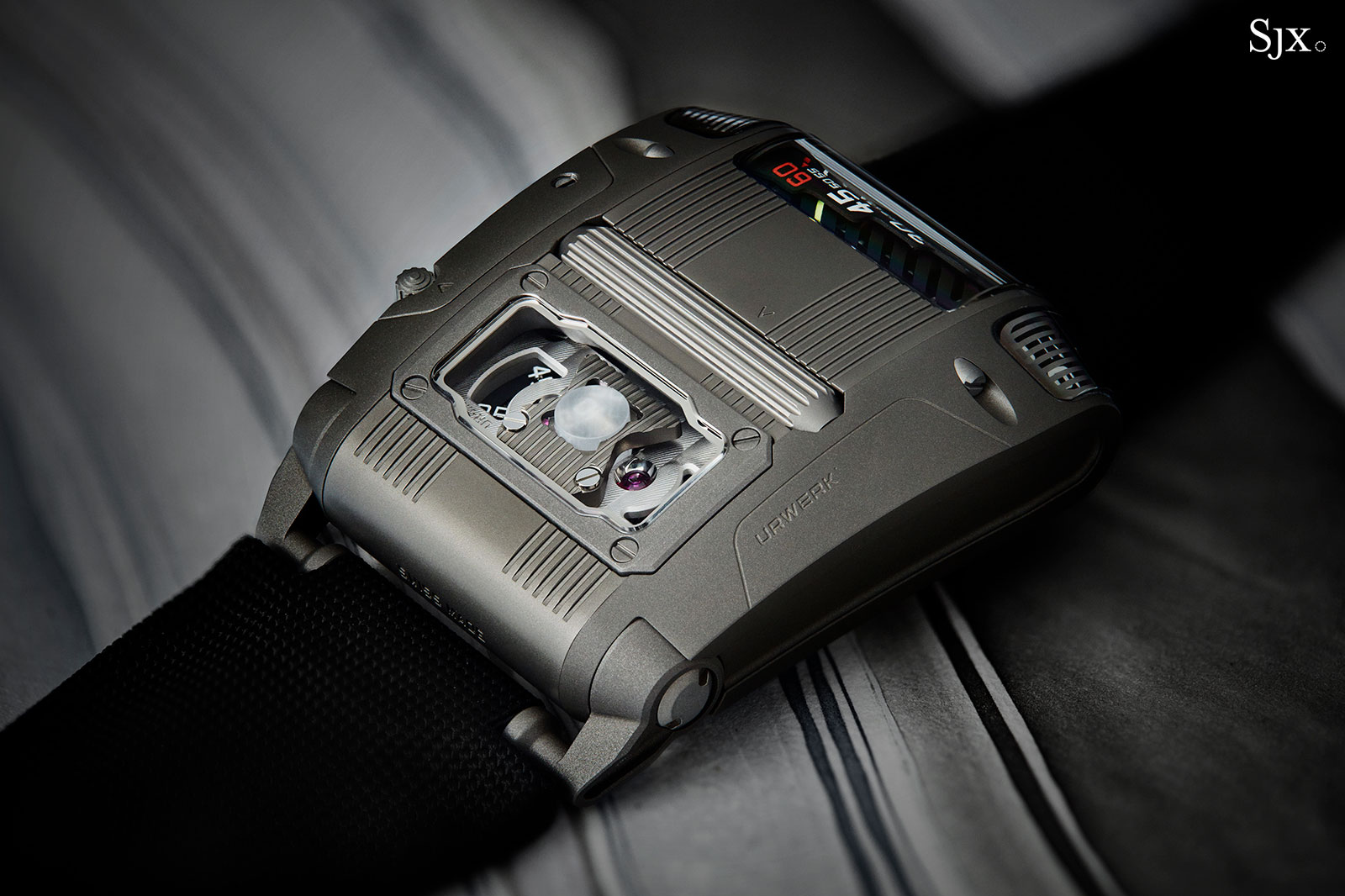
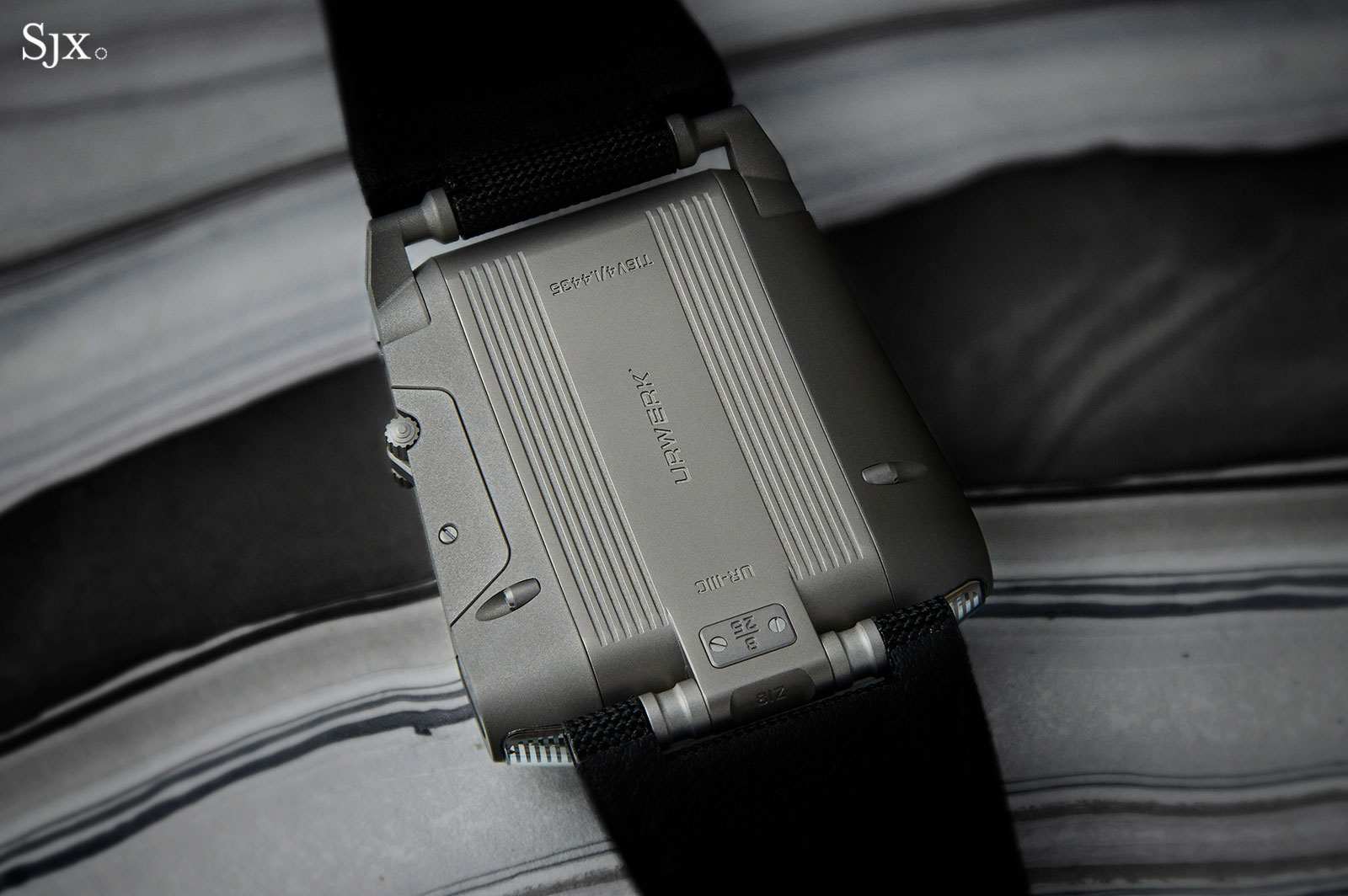
Aside from the lengthwise fluting on the case, front and back, the design is restrained, with much of it being functional, as a consequence of how the case is put together. The two exposed holes for screws above each conical drum (which are also found on the case back) are to secure the case, which is built like a sleeve to house the movement. The movement is mounted on the right flank of the case, which serves almost as a base plate, and then slides into the case middle.
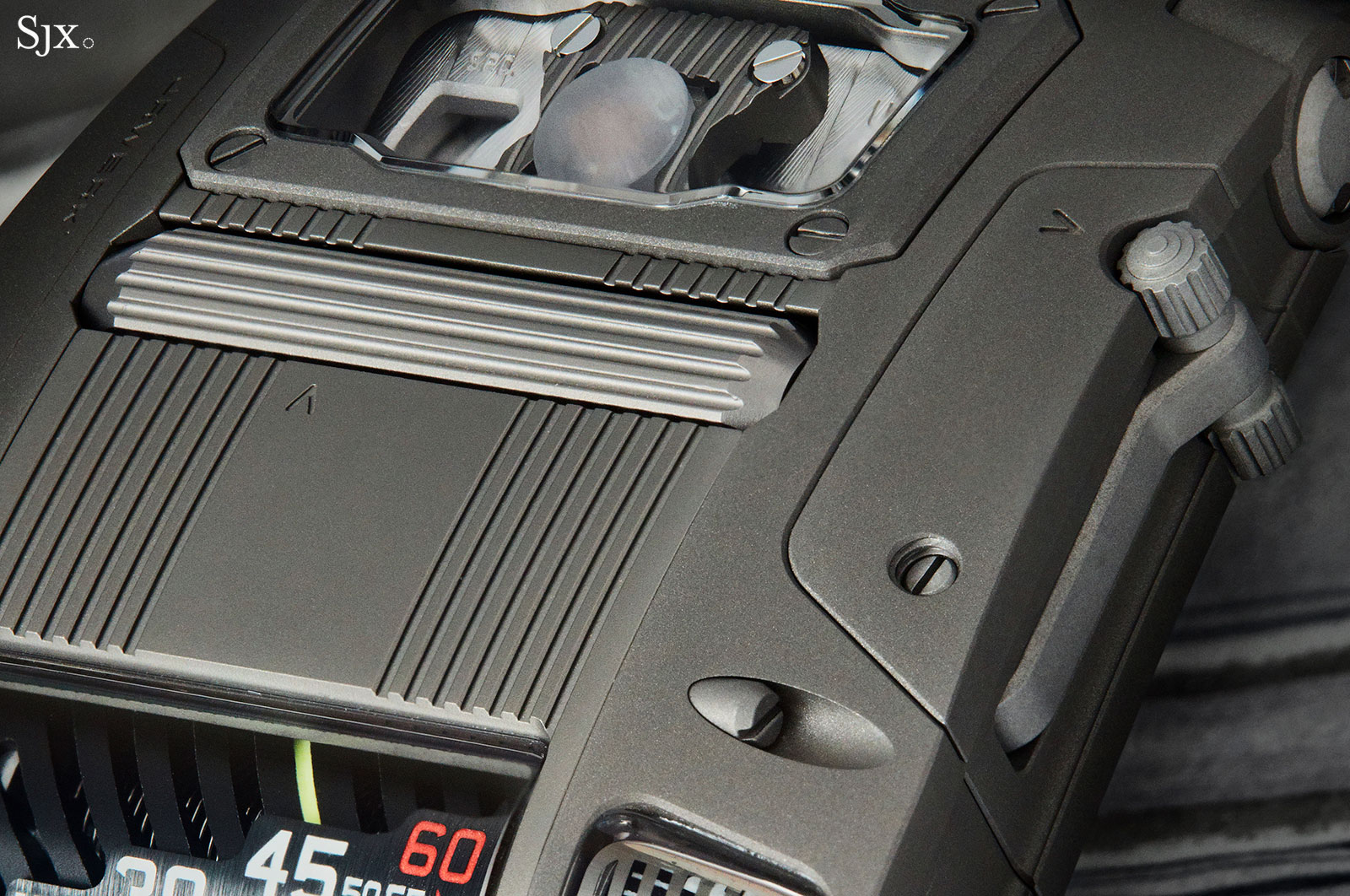
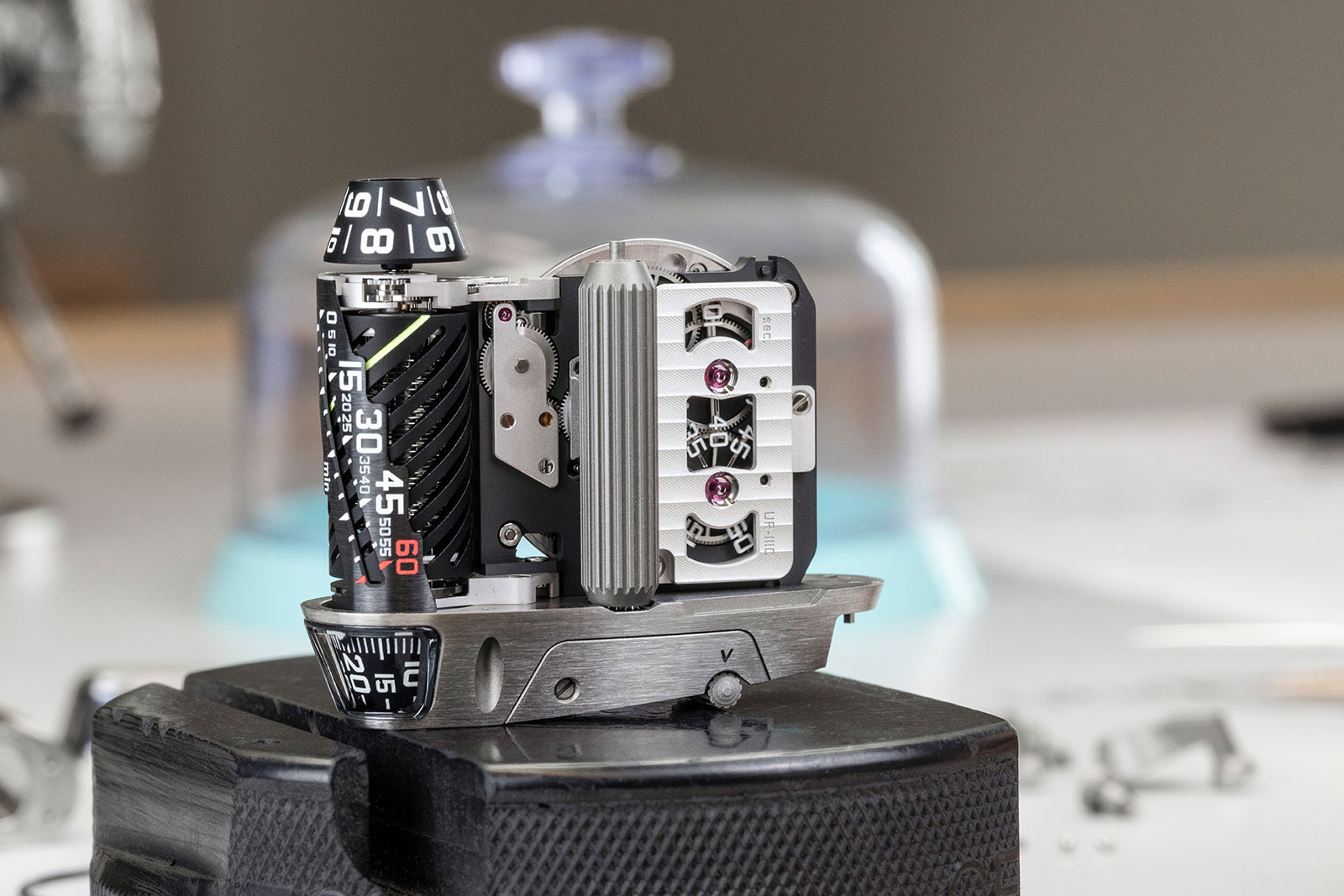
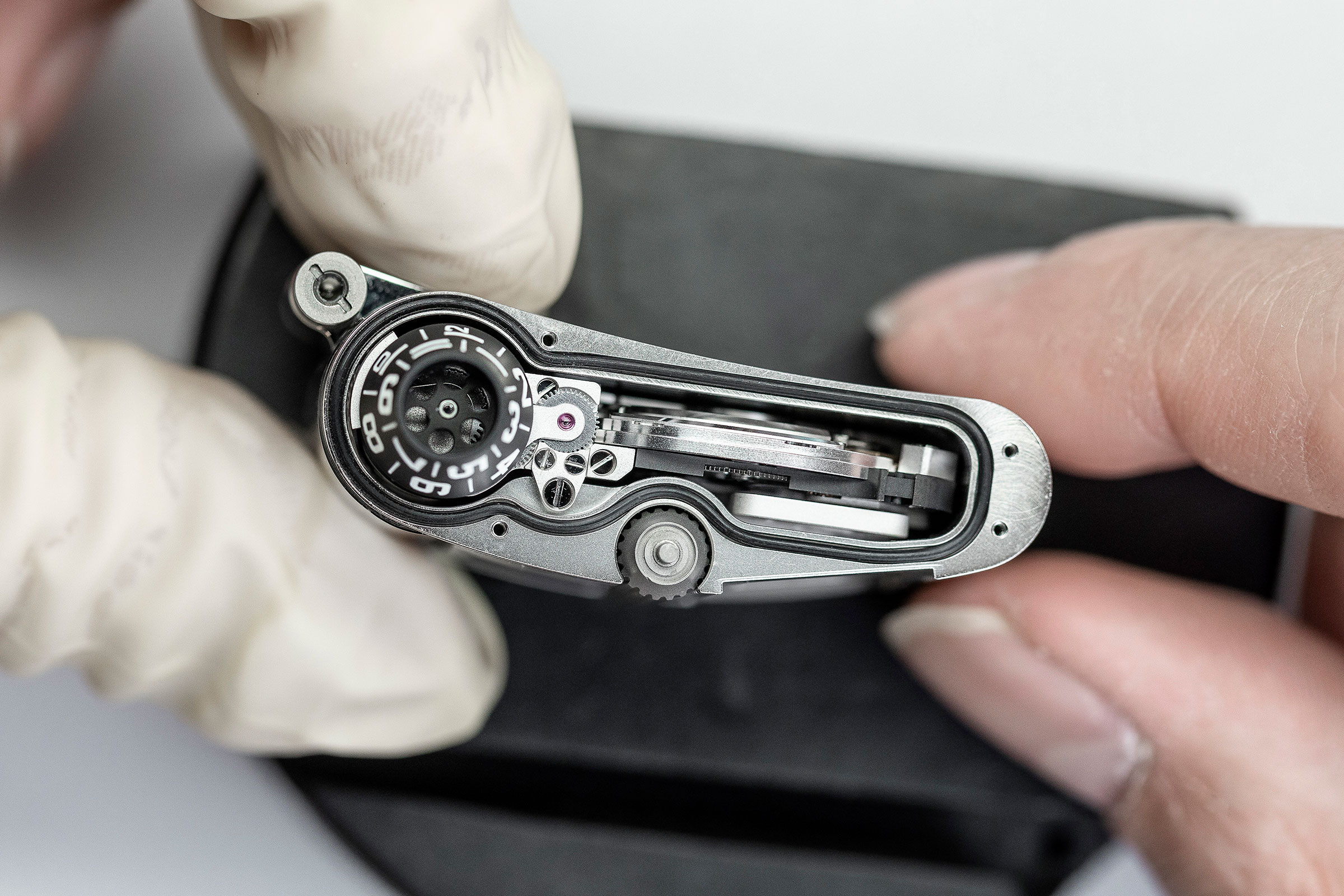
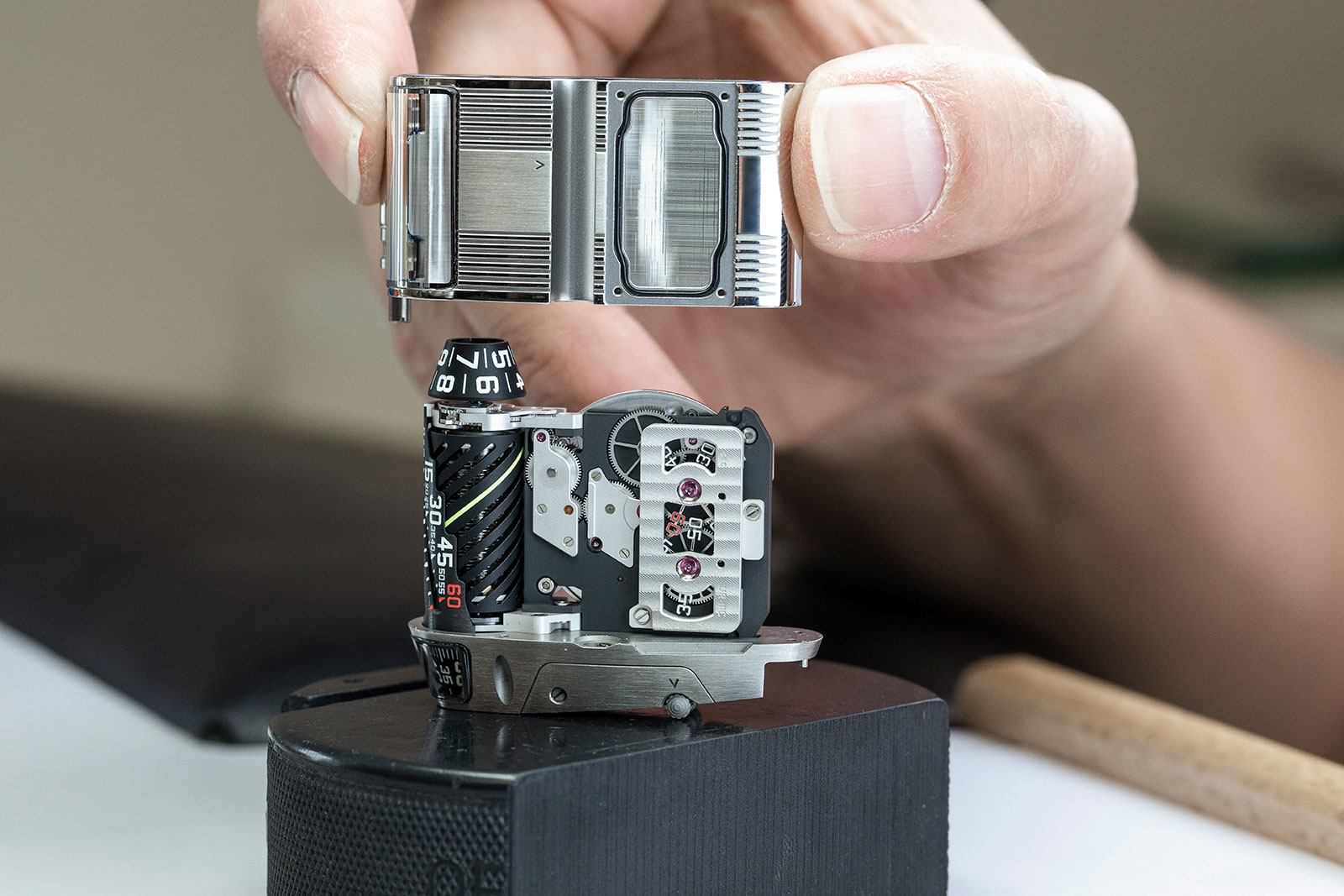
Slotting the movement into the case middle. Photo – Urwerk
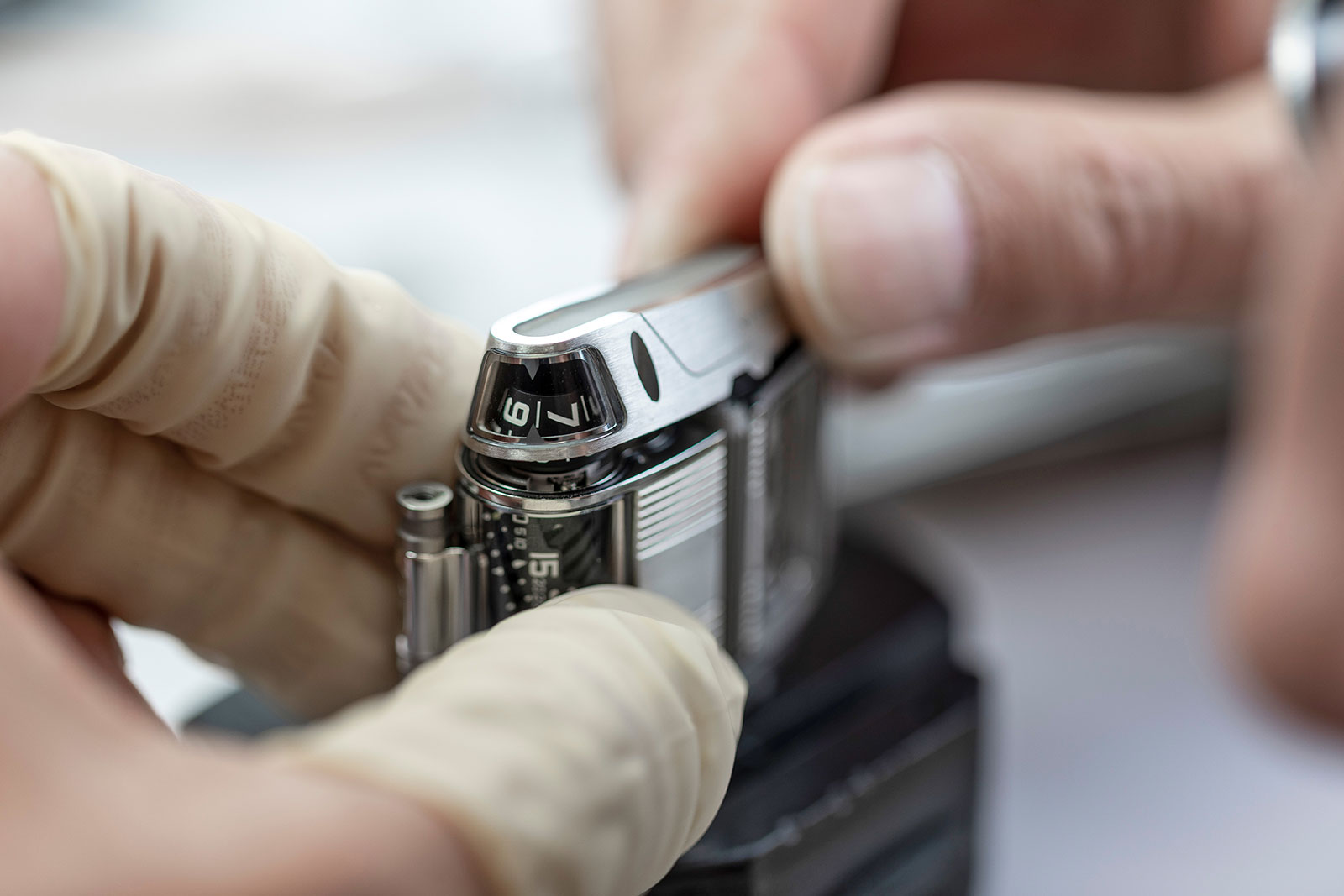
Closing off the case with the left flank. Photo – Urwerk
Two case finishes are available for the UR-111C: brushed steel in its natural colour, or a granular, medium grey “gunmetal” coating as pictured. The grey finish fits the highly mechanical appearance of the watch perfectly, though the brushed steel looks more like a high-end watch thanks to its silvery colour and shine.
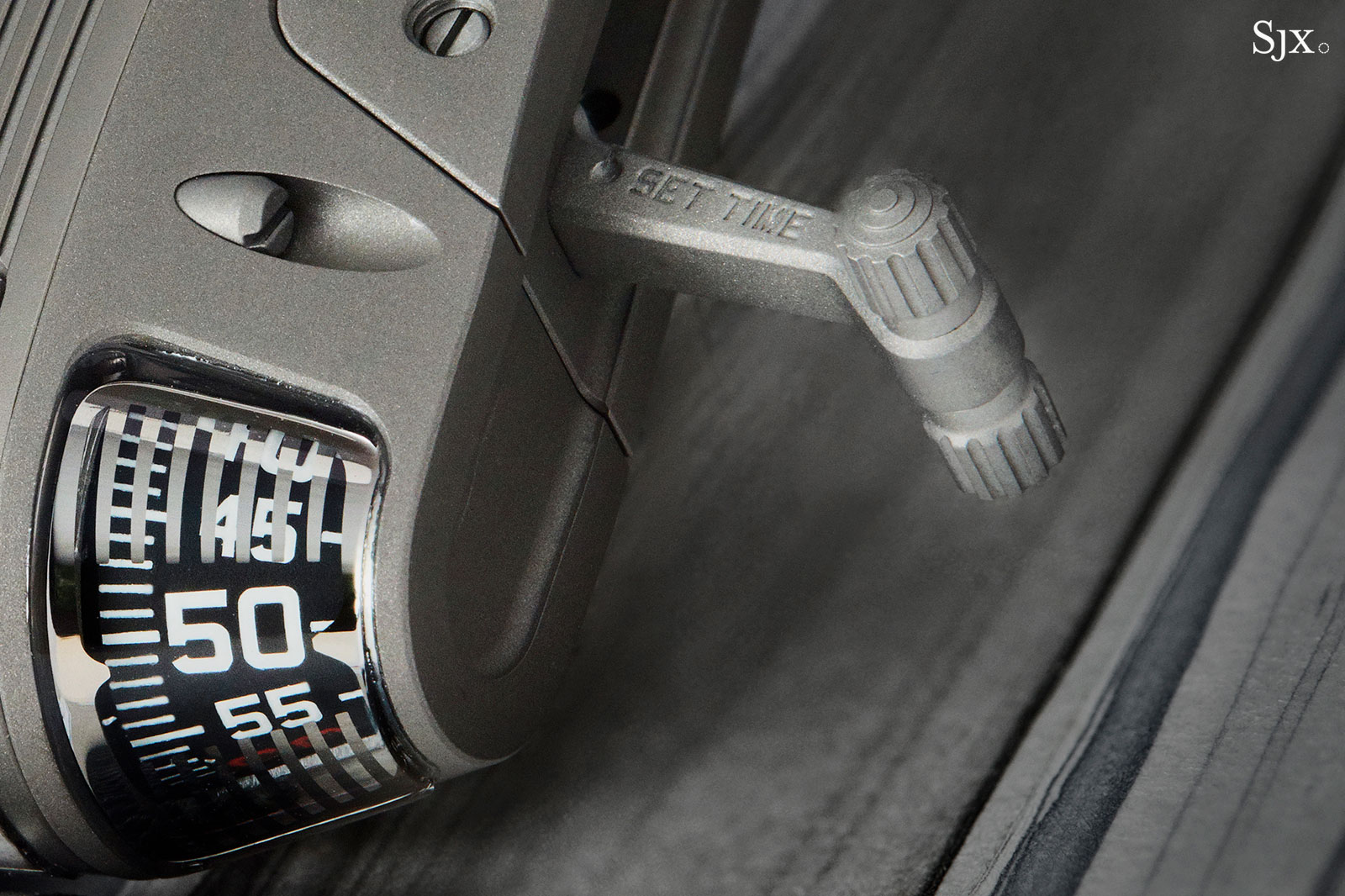
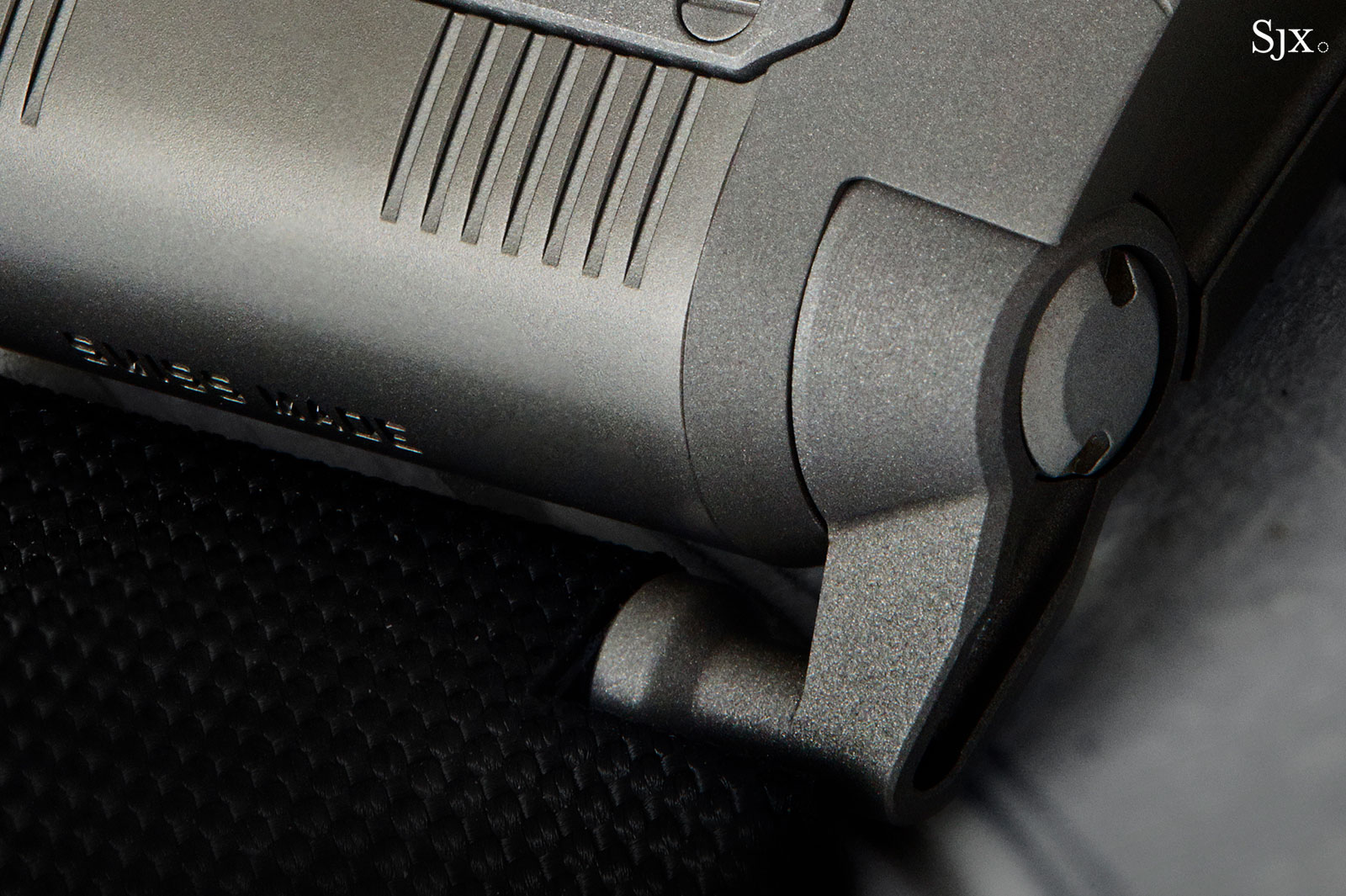
Pricing
Limited to 25 in each finish, the UR-111C is priced at SFr130,000 before taxes. It is already available from Urwerk retailers.
Update October 30, 2018: Images of case assembly process added.
Correction October 31, 2018: The twin discs pictured are for the seconds, and not the date as previously written.
Back to top.
